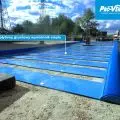{tag:studenci}, a student of the Faculty of Architecture at the Cracow University of Technology, proposed to transform Juliusz Kossak Square in Cracow from a sad, gray parking lot into a space full of nature, dedicated to the residents. An additional element is a coffee pavilion where people can meet and relax. The goal of the project? To restore the natural essence of the urban area and promote biodiversity.
The project presented here was created during the third semester of the undergraduate course Integrated Design III—Urban Interiors at the Landscape Architecture Department at the Cracow University of Technology. The theme of the assignment was to reclaim public space, which should be Juliusz Kossak Square in Cracow. Katarzyna Jamioł developed her project under the guidance of Dr. Urszula Forczek-Brataniec, Prof. PK and Dr. Wojciech Rymsza-Mazur, Prof. PK.
The topic of the reconstruction of Juliusz Kossak Square was also the task of a competition organized in 2021 by the Board of Urban Greenery in Cracow and SARP Cracow. The competition was won by the ngo + pasierbiński studio, but the idea has not been realized so far, as the project was stuck with the municipal conservator.
design guidelines for the square area
© Katarzyna Jamioł
The student began her design work with detailed research, which took into account the specifics of the square and its location within a larger urban context. In the first stage, she carefully assessed its value and location within the area of ecological protection of the city of Cracow, the network of ecological corridors and flood risk. It then carefully analyzed the form, function and exposure of the square.
The goal of the project is to transform the square into a colorful flower garden
© Katarzyna Jamioł
The purpose of the form study was to understand the current spatial layout of the square, taking into account the size and architectural features. In addition, the functional study showed patterns of activity and use, which helped determine how people use specific parts of the square. The main purpose of developing the exposition was to find important vantage points from which there is an expansive view of Kossakówka, Vistula Boulevards and Wawel Castle. I also determined what features should be emphasized and what elements could be subtly included or hidden. Developing design assumptions for each aspect of the square's interior was possible thanks to the evaluation process," explains Katarzyna Jamioł of the design process.
spatial analysis of Kossak Square
© Katarzyna Jamioł
Juliusz Kossak square full of flowers
The research allowed the PK student to develop a design for the revitalization of Juliusz Kossak Square. Her proposal is a harmonious combination of landscaping and architecture, and the goal is to restore the natural essence of the urban area, encouraging the community to appreciate and promote biodiversity. The main idea is to bring nature into a space currently dominated by parked cars. The goal is to transform the square into a colorful flower garden with melliferous plants and carefully planned flower beds.
The transformation of Juliusz Kossak Square, diagrams of the project's creation
© Katarzyna Jamioł
My concept is to create a living canvas in the urban landscape that celebrates the creative legacy of Juliusz Kossak. It is intended to allow passersby to fully immerse themselves in art, culture and nature. The colors of the painter's paintings are reflected in the selection of plants, spatial arrangements and materials used. This increases the visual attractiveness of the square," explains the author.
meeting place is the coffee pavilion
© Katarzyna Jamioł
The student also introduced modern methods of sustainable water management—rain gardens and absorption wells under the seats. Their use reduces surface runoff, collects rainfall and recharges groundwater. As the author argues, such solutions strengthen environmental resilience.
coffee pavilion design
© Katarzyna Jamioł
coffee pavilion
The main attraction of the square is the cafe pavilion, designed for those seeking peace and quiet in a fairly busy area. The pavilion serves as a center where Cracow residents and tourists can meet, building a sense of community.
The author has brought life into the square space
© Katarzyna Jamioł
The concept of transforming an average parking lot into a vibrant, biodiverse area exemplifies the impact that design has on reintroducing nature into the urban fabric. It shows how design can transform a square inaccessible to residents into a vibrant area of coexistence between urban life and the natural world, concludes Katarzyna Jamioł.












































